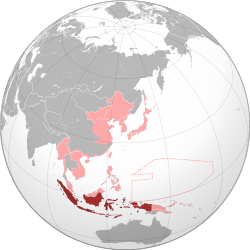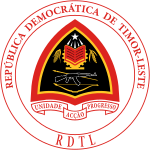
Back الاحتلال الياباني للهند الشرقية الهولندية Arabic Yaponiyanın Niderland Ost-Hindini işğalı Azerbaijani Kriegsverbrecherprozesse in Niederländisch-Indien German Japana okupado de Nederlanda Hindio Esperanto Ocupación japonesa de las Indias Orientales Neerlandesas Spanish تصرف هند شرقی هلند توسط ژاپن Persian Japanilaisten miehitys Indonesiassa Finnish Occupation japonaise des Indes néerlandaises French Pendudukan Jepang di Hindia-Belanda ID Occupazione giapponese delle Indie orientali olandesi Italian
Japanese-occupied Dutch East Indies Japanese East Indies 日本占領下のオランダ領東インド (Japanese) Nihon senryō-ka no orandaryōhigashiindo (Romaji) Pendudukan Jepang di Hindia-Belanda (Indonesian) | |||||||||||||||
|---|---|---|---|---|---|---|---|---|---|---|---|---|---|---|---|
| 1942–1945 | |||||||||||||||
| Motto: Hakkō ichiu (八紘一宇) | |||||||||||||||
| Anthem: Kimigayo Indonesia Raya (unofficial) | |||||||||||||||
 The former Dutch East Indies (dark red) within the Empire of Japan (light red) at its furthest extent | |||||||||||||||
| Status | Military occupation by the Empire of Japan | ||||||||||||||
| Capital | Djakarta | ||||||||||||||
| Common languages | Japanese, Indonesian, Dutch | ||||||||||||||
| Emperor | |||||||||||||||
• 1942–1945 | Hirohito | ||||||||||||||
| Historical era | World War II | ||||||||||||||
| 8 March 1942 | |||||||||||||||
| 1941–1945 | |||||||||||||||
| 27 February 1942 | |||||||||||||||
| 1 March 1942 | |||||||||||||||
• Pontianak incidents (Pontianak massacres) | 1943–1944 | ||||||||||||||
| 14 February 1945 | |||||||||||||||
| 15 August 1945 | |||||||||||||||
| 17 August 1945 | |||||||||||||||
| Currency | Netherlands Indian roepiah | ||||||||||||||
| |||||||||||||||
| Today part of | Indonesia East Timor | ||||||||||||||
| History of Indonesia |
|---|
 |
| Timeline |
|
|
| History of East Timor |
|---|
 |
| Chronology |
| Topics |
|
|
The Empire of Japan occupied the Dutch East Indies (now Indonesia) during World War II from March 1942 until after the end of the war in September 1945.
In May 1940, Germany occupied the Netherlands, and martial law was declared in the Dutch East Indies. Following the failure of negotiations between the Dutch authorities and the Japanese, Japanese assets in the archipelago were frozen. The Dutch declared war on Japan following the 7 December 1941 attack on Pearl Harbor. The Japanese invasion of the Dutch East Indies began on 10 January 1942, and the Imperial Japanese Army overran the entire colony in less than three months. The Dutch surrendered on 8 March. [1] Initially, most Indonesians welcomed the Japanese as liberators from their Dutch colonial masters. The sentiment changed, however, as between 4 and 10 million Indonesians were recruited as forced labourers (romusha) on economic development and defense projects in Java. Between 200,000 and 500,000 were sent away from Java to the outer islands, and as far as Burma and Siam. Of those taken off Java, not more than 70,000 survived the war.[2] Four million people died in the Dutch East Indies as a result of famine and forced labour during the Japanese occupation, including 30,000 European civilian internee deaths.[3]
In 1944–1945, Allied troops largely bypassed the Dutch East Indies and did not fight their way into the most populous parts such as Java and Sumatra. As such, most of the Dutch East Indies was still under occupation at the time of Japan's surrender in August 1945.
The invasion and occupation was the first serious challenge to Dutch colonial rule and brought about changes so extensive the subsequent Indonesian National Revolution became possible.[4] Unlike the Dutch, the Japanese facilitated the politicisation of Indonesians down to the village level.[citation needed] The Japanese educated, trained and armed many young Indonesians and gave their nationalist leaders a political voice.[citation needed] Thus, through both the destruction of the Dutch colonial regime and the facilitation of Indonesian nationalism, the Japanese occupation created the conditions for the proclamation of Indonesian independence within days of the Japanese surrender in the Pacific.[citation needed] However, the Netherlands sought to reclaim the Indies, and a bitter five-year diplomatic, military and social struggle ensued, resulting in the Netherlands recognising Indonesian sovereignty in December 1949.
- ^ Ricklefs 2008, p. 323-325.
- ^ Ricklefs 2008, p. 337.
- ^ Dower 1986, p. 296.
- ^ Ricklefs 2008, p. 325.
© MMXXIII Rich X Search. We shall prevail. All rights reserved. Rich X Search


